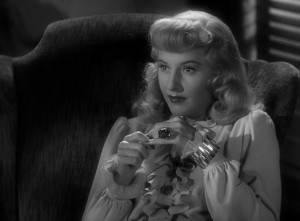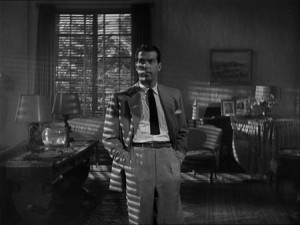This year marks the 70th anniversary of one of the greatest film noir ever made, perhaps the quintessential title of that perpetually popular and occasionally fluid cinematic category. To celebrate the occasion, a new restoration of Billy Wilder’s Double Indemnity premiered at the recent TCM Classic Film Festival, and the film had its American Blu-ray debut in April. To treat this movie with reverence is understandable. From story and stars to direction and dialogue, everything about this 1944 classic sizzles. It’s little wonder the picture garnered seven Academy Award nominations upon its release and in 2007 ranked among the top 30 American films ever made, according to the AFI. To paraphrase main character Walter Neff (Fred MacMurray), it’s a honey of a movie.

First published as a serial by James M. Cain in 1936, the property took nearly eight years to finally get the go-ahead from a Hollywood studio. With all the adultery and murder, this was a tough sell, especially on the heels of the Hays Code crackdown. Eventually, everything fell together and the official script writing was underway, a process not without some drama itself. Raymond Chandler was brought in to jazz it up with some of his noted colloquial flair, but he and co-writer/director Wilder didn’t exactly see eye to eye. Whatever the behind-the-scenes antagonism may have been though, the final product speaks for itself. And speak does it ever. There’s much to admire about Double Indemnity, but its dialogue may be its most enjoyable feature. Take one often-cited example:
Phyllis: There’s a speed limit in this state, Mr. Neff. Forty-five miles an hour.Nobody talks like this…and it’s fantastic! This kind of witty banter never lets up; it’s almost comically persistent, audaciously and self-consciously clever.
Walter: How fast was I going, officer?
Phyllis: I’d say around ninety.
Walter: Suppose you get down off your motorcycle and give me a ticket.
Phyllis: Suppose I let you off with a warning this time.
Walter: Suppose it doesn’t take.
Phyllis: Suppose I have to whack you over the knuckles.
Walter: Suppose I bust out crying and put my head on your shoulder.
Phyllis: Suppose you try putting it on my husband’s shoulder.
In the film, Walter Neff is a top-notch insurance salesman who plans to sell an inconsequential auto policy to Mr. Dietrichson (Tom Powers). Upon visiting the Dietrichson household, however, Neff is quickly, severely, and tragically sidetracked by the missus. Phyllis Dietrichson (Barbara Stanwyck) is seductive, sharp, and conniving—the embodiment of the femme fatale—and Walter falls hard for her wiles, her looks, and her anklet. The rapidly escalating affair between Walter and Phyllis leads to a mutual scheme (initiated by Phyllis, eagerly endorsed by Walter) to do away with her husband, only after he unknowingly signs off on a hefty accident insurance policy. Once the deed is done, paranoia sets in (this is noir, after all). Driving the anxiety is claims adjuster, and long-time colleague and friend of Walter’s, Barton Keyes (Edward G. Robinson), who gradually begins to smell a rat.

The insurance business is an ideal vocation for film noir, and it works perfectly here. These are people who make death, accidents, and suspicion part of their profession. Keyes has a clear passion for his work and is a wolf at spotting phony claims. There’s an almost Hitchcockian revelry in the way Keyes rattles off types of suicide and murder possibilities, conveying his vast expertise in this macabre field. He’s also got a “little man,” somehow connected to indigestion, and this alerts him to claims that aren’t on the up and up. As for Neff, he’s the top salesman at the company, skilled at selling whatever he needs to, however he needs to do it. This means we have competency on both sides. And as in a Howard Hawks film, a stress on the occupation itself runs throughout the film. It sometimes seems that Neff gets into the whole ordeal as much out of a professional challenge as he does through his infatuation with Phyllis. He knows the insurance game inside and out. Can he buck his own system, cheat at his own game, fool Keyes’ “little man”?
Still though, it is film noir, so the girl is the more evident part of the equation, as is pure and simple monetary gain. Upon her first appearance (where she, like her husband, is not “fully covered”), Phyllis exudes a potent and knowing sexuality. As her murderous ultimate goal comes to light, Neff at first plays the morally wounded soul, outraged at a suggestion as scandalous as killing her husband, but as he admits, the hooks are too strong. Aiding in their decision is Mr. Dietrichson’s personality. He is grouchy and bossy and he’s apparently abusive—at least that’s what Phyllis says. As much as this seals the deal for them, it also helps keep the audience’s allegiance uncomfortably on the side of Walter and Phyllis. Of course, Mr. Dietrichson’s behavior is no excuse for murder, but certainly it does contribute to the ultimate viewer alignment in Double Indemnity, and so many suspenseful noirs like it: that we, the decent and ethically superior viewer, are totally committed to the bad people. We fret when there’s a kink in their plans, such as a potentially postponed trip or a stranger on the observation deck, and we breathe a sigh of relief along with them as Keyes initially backs up the supposed accident hypothesis.

This leads to a strong sense of cynicism, a term commonly applied to Billy Wilder and for good reason. It’s no surprise that film noir, that most jaded and pessimistic form of motion picture, was such a natural fit for the director. In this mode, he’s able to challenge not only issues of principled association, like those just mentioned, but also social institutions and human nature itself. The famous scenes in the grocery market are good examples. Amidst the shoppers busily and obliviously filling their carts, Walter and Phyllis contemplate murder. In this setting of banal consumerist custom, Wilder has death and deceit right next to the instant coffee and canned beans. It’s a darkly ironic and comic juxtaposition, like murder smelling of honeysuckle. And it seems almost inevitable that by the end, Walter and Phyllis will turn on each other. She’s so calm and collected about planning the murder (almost as if she’s been here before). In fact, Dietrichson’s daughter Lola (Jean Heather) knows Phyllis is wicked, and tries to convince Walter that she was behind the death of Dietrichson’s first wife. Walter begins to wonder, but his doubts lack conviction. The duo’s association is, of course, destined to fail, and not just because the production code would have had it that way, or because the film begins with the end where we’re basically told how things turn out (Neff says he killed for a woman and money, and he doesn’t get either). Moreover, as Keyes says, when two people are involved in a plot like this, it’s “ten times twice as dangerous.”
All the aesthetic hallmarks of noir are in Double Indemnity as well. Venetian blinds, a set decorating godsend to film noir, produces distinct shafts of light permeating dust-littered interiors, creating a stunning balance of light and dark, one that, as several critics have pointed out, creates bars already entrapping the characters. And while it’s always (ironically) sunny outside in the daytime, the nights are as dark as can be. Throughout the film, Wilder and cinematographer John F. Seitz design scenes in the deepest and darkest of shadows. And through this visual design, viewers can begin to appreciate the symbolic implications; in this film, with these people, there’s a lot to hide. This type of mise-en-scène construction certainly stands out, as it’s supposed to with film noir, but otherwise, Wilder maintains a reluctance to get overly stylish. Never a fan of “fancy schmancy” camera moves or angles, Wilder focuses more on having the camera just where it needs to be to adequately, yet creatively, capture the drama. In some cases, as in the shot down Neff’s apartment building hallway, where Phyllis hides from Keyes behind Walter’s open door, that ideal placement also works out to be visually ingenious as well.

Variations of eventually adopted noir traits appeared in many features prior to 1944, foreign and domestic, but it’s with reasonable justification that Double Indemnity is considered the first true film noir, where there is a notably cohesive accumulation of these formal attributes into one film. If this is the case, the bar was now set quite high. The same could be said for Wilder as a filmmaker. With this film, just his third directorial effort in Hollywood, he proved himself a major figure behind the camera and the typewriter. He would clear this early bar at least five times over the next two decades.
REVIEW from FILM INTERNATIONAL

No comments:
Post a Comment